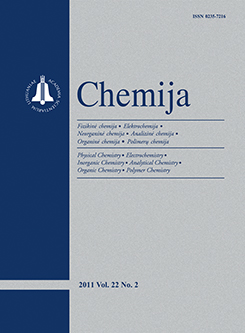Chemija / Chemistry
 ISSN 0235-7216 ISSN 2424-4538 (online) |
2011 m. Nr. 2 Two-electron reduction of nitroaromatic compounds by Thermotoga maritima hybrid peroxiredoxin–nitroreductase enzyme
Explosives such as 2,4,6-trinitrotoluene (TNT) and related polynitroaromatics being toxic environmental pollutants, numerous efforts are directed towards their biodegradation. In this work, we studied the NADPH-dependent two-electron reduction of a number of nitroaromatic compounds by a peroxiredoxin–nitroreductase hybrid enzyme from Thermotoga maritima (Prx–NR). We have found that the peroxiredoxin and nitroreductase domains of Prx–NR function independently. The activity of Prx–NR towards nitroaromatics is not influenced by their particular structure and is characterized by a linear log kcat / Km dependence on their single-electron reduction potentials (E1 7). The reduction of polynitroaromatic explosives N-nitramines such as tetryl (2,4,6-trinitrophenyl-N-methylnitramine) and pentryl (2,4,6-trinitrophenyl-N-nitroaminoethylnitrate) was accompanied by the formation of nitrite, which implies their reductive N-denitration, while p-dinitrobenzene is reduced to p-hydroxylaminonitrobenzene. Taken together, these data indicate that nitroreductase reactions of Prx–NR share common features with those of other bacterial oxygen-insensitive nitroreductases, e. g., Enterobacter cloacae nitroreductase. However, the activity of Prx–NR is 10–100 times lower than that of E. cloacae NR.
Keywords: 2,4,6-trinitrotoluene, explosives, nitroreductases, biodegradation, bioreductive activation |
Issues:
2017 - Vol.28 No. 1, No. 2, No. 3, No. 4 2016 - Vol.27 No. 1, No. 2, No. 3, No. 4 2015 - Vol.26 No. 1, No. 2, No. 3, No. 4 2014 - Vol.25 No. 1, No. 2, No. 3, No. 4 2013 - Vol.24 No. 1, No. 2, No. 3, No. 4 2012 - Vol.23 No. 1, No. 2, No. 3, No. 4 2011 - Vol.22 No. 1, No. 2, No. 3, No. 4 2010 - Vol.21 No. 1, No. 2-4 2009 - Vol.20 No. 1, No. 2, No. 3, No. 4 2008 - Vol.19 No. 1, No. 2, No. 3-4 2007 - Vol.18 No. 1, No. 2, No. 3, No. 4 2006 - Vol.17 No. 1, No. 2-3, No. 4 2005 - Vol.16 No. 1, No. 2, No. 3-4 2004 - Vol.15 No. 1, No. 2, No. 3, No. 4 2003 - Vol.14 No. 1, No. 2, No. 3, No. 4 2002 - Vol.13 No. 1, No. 2, No. 3, No. 4 2001 - Vol.12 No. 1, No. 2, No. 3, No. 4 |